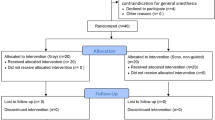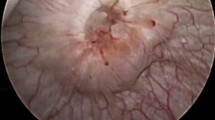Abstract
Objective
The optimal management of patients with ureteric obstruction in advanced malignancy is unclear. How quality of life is affected by a nephrostomy and how many of these patients undergo further oncological treatment remains uncertain. The objective of this retrospective multicentre study was to look at the outcomes of patients who had percutaneous nephrostomy insertion for malignancy.
Methods
We identified patients who had a nephrostomy inserted for ureteric obstruction due to malignancy at our institution from January 2015 to December 2018. We obtained data retrospectively from our electronic patient record system. Patients who had nephrostomy insertion for other causes such as ureteric calculi or injury were excluded from the study.
Results
105 patients underwent nephrostomy insertion during this time interval. 51.42% patients (n = 54) had urological malignancies (bladder and/or prostate cancer). The median LOS was 14 days (range 1–104 days) post-procedure and 39.04% (n = 41) had at least one 30-day readmission to hospital. The average starting creatinine level was 348 mmol/L (range 49–1133) and the average creatinine at discharge was 170 mmol/L (range 44–651). Although the average change in the creatinine (190 mmol/L) is statistically significant (p < 0.001), it did not seem to prolong life of the patients. Only 26 (24.76%) patients were alive (all-cause mortality) at the end of the 4-year period with an average life expectancy of 139 days following nephrostomy. Only 30.47% (n = 32) patients underwent further oncological treatment.
Conclusion
In our series, most patients who had nephrostomy insertion for ureteric obstruction due to malignancy had no further oncological treatment following insertion. Percutaneous nephrostomy is a procedure not without associated morbidity and does not always prolong survival. Due to the poor prognosis in cases of advanced malignancy, we advocate multi-disciplinary decision-making prior to nephrostomy insertion.
Similar content being viewed by others
References
Matsuura H, Arase S, Hori Y (2019) Ureteral stents for malignant extrinsic ureteral obstruction: outcomes and factors predicting stent failure. Int J Clin Oncol 24(3):306–312
Prentice J, Amer T, Tasleem A, Aboumarzouk O (2018) Malignant ureteric obstruction decompression: how much gain for how much pain? A narrative review. J R Soc Med 111:125–135
Cordeiro MD et al (2016) A prognostic model for survival after palliative urinary diversion for malignant ureteric obstruction: a prospective study of 208 patients. BJU Int. 117:266–271
Wilson JR, Urwin GH, Stower MJ (2005) The role of percutaneous nephrostomy in malignant ureteric obstruction. Ann R Coll Surg Engl 87:21
Dienstmann R, da Silva Pinto C, Pereira MT, Small IA, Ferreira CG (2008) Palliative percutaneous nephrostomy in recurrent cervical cancer: a retrospective analysis of 50 consecutive cases. J. Pain Symptom Manage. 36:185–190
Lapitan MCM, Buckley BS (2011) Impact of palliative urinary diversion by percutaneous nephrostomy drainage and ureteral stenting among patients with advanced cervical cancer and obstructive uropathy: A prospective cohort. J Obstet Gynaecol Res 87:21
Wong LM, Cleeve LK, Milner AD, Pitman AG (2007) Malignant ureteral obstruction: outcomes after intervention. have things changed? J Urol 178:178–183
Boja RM, Porav-Hodade D, Martha OK, Vass L (2010) Definitively circular percutaneuos nephrostomy. Eur Urol Suppl. 96:661
Ishioka J, Kageyama Y, Inoue M, Higashi Y, Kihara K (2008) Prognostic model for predicting survival after palliative urinary diversion for ureteral obstruction: analysis of 140 cases. J Urol 180:618–621
Izumi K, Mizokami A, Maeda Y, Koh E, Namiki M (2011) Current outcome of patients with ureteral stents for the management of malignant ureteral obstruction. J Urol 185:556–561
Monsky WL et al (2013) Quality-of-life assessment after palliative interventions to manage malignant ureteral obstruction. Cardiovasc Intervent Radiol 36:1355–1363
Macneil HF, Hall RR, Neal DE, Roberts JT (1991) Systemic chemotherapy for urothelial cancer in patients with ureteric obstruction. Br J Urol 67:169–172
Uthappa MC, Cowan NC (2005) Retrograde or antegrade double-pigtail stent placement for malignant ureteric obstruction? Clin Radiol 60:608–612
Shekarriz B et al (1999) Outcome of palliative urinary diversion in the treatment of advanced malignancies. Cancer 85:998–1003
Makris K, Spanou L (2016) Acute kidney injury: diagnostic approaches and controversies. Clin Biochem Rev. 37(4):153–175
Moran SM, Myers BD (1985) Course of acute renal failure studied by a model of creatinine kinetics. Kidney Int 27:928–937
Bragadottir et al (2013) Assessing glomerular filtration rate (GFR) in critically ill patients with acute kidney injury-true GFR versus urinary creatinine clearance and estimating equations. Crit Care 17:R108
Author information
Authors and Affiliations
Corresponding author
Additional information
Publisher's Note
Springer Nature remains neutral with regard to jurisdictional claims in published maps and institutional affiliations.
Rights and permissions
About this article
Cite this article
Folkard, S.S., Banerjee, S., Menzies-Wilson, R. et al. Percutaneous nephrostomy in obstructing pelvic malignancy does not facilitate further oncological treatment. Int Urol Nephrol 52, 1625–1628 (2020). https://doi.org/10.1007/s11255-020-02466-2
Received:
Accepted:
Published:
Issue Date:
DOI: https://doi.org/10.1007/s11255-020-02466-2




